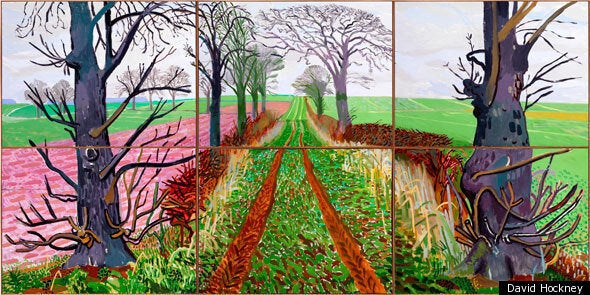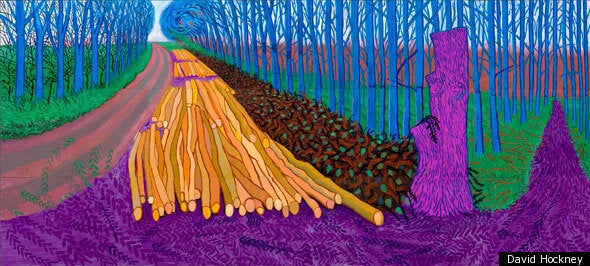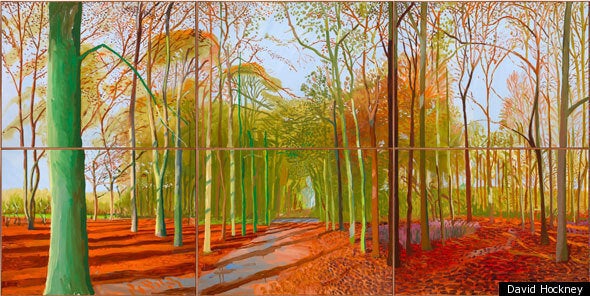
In Kazuo Ishiguro’s novel The Remains of the Day, the lead character observes:
"The English landscape at its finest possesses a quality that the landscapes of other nations, however more superficially dramatic, inevitably fail to possess. It is, I believe, a quality... best summed up by the term 'greatness.'"
David Hockney has spent the past seven years sat amongst the hedgerows and woodlands of his native East Yorkshire obsessively capturing – and in some cases, dramatising - precisely this quiet and understated ‘greatness’. It is the results of this endeavour that fill A Bigger Picture at the Royal Academy, the first of 2012’s blockbuster art exhibitions.
Anyone who grew up exploring the Wolds – or any rural part of England – will instantly recognise Hockney’s England as their own: tree stumps and crooked paths, sudden plumes of wild flowers and wicked thickets of nettles, red-brown roads splattered with mazy puddles and trees whose outer branches glisten, and inner branches rest in shadow.

A Closer Winter Tunnel, February - March, 2006
Hockney captures it all, and there is an appealing irony in the fact that these intense portrayals of nature have been composed partly on that totem of modernity, the iPad.
The largest section of the exhibition, The Arrival of Spring, features 51 iPad drawings of the same country road at various points in the year. The results vary. Where Hockney offsets the vivid swells of colour with short, sharp lines, the images have depth and vitality and a strange beauty. Elsewhere, the palette is overwhelming and the scenes fall flat, giving the prints an unwelcome digital quality.
Thankfully, most of the rest of the show is dominated by paintings, and if Picasso is the most obvious influence on Hockney’s style, the concept is all Monet.
Inspired by a visit to the Musee de l’Orangerie where the famous Nympheas (water lilies) hang in a circular room to immerse visitors in the landscapes, Hockney repeats the trick by painting across huge, 6-canvass grids on which he captures different scenes – a section of woodland, a split tree trunk, an overgrown path – all from identical perspectives but at different times. They are then arranged around the Royal Academy's rooms in a cocooning affect.
One of the most impressive aspects of the exhibition is this way in which the space feels custom-made for the paintings, even though it's really the other way around. The first series Three Trees Near Thixendal is displayed across four walls of an octagonal room, meaning you can stand in the middle and view them all in one 360 degree motion.

Winter Timber, 2009
The largest wall in the main gallery was presented to Hockney as a challenge, and he responded by filling it with the enormous and startling main image from The Arrival of Spring - though curiously, for all their impressive scale, it is some of the larger works (the ones currently decorating Green Park tube station as though heralding a jubilee) that make the least impact.
The bright blue trees, scorched yellow logs and deep purple grass of Winter Timber are loud and vivid but less far beguiling than, for example, the smaller paintings from the Wolgate Woods series, in which the melancholy of a late Autumn dusk, the tremble of a chilly Winter morning and the unabashed beauty of a summers day slanting through the trees are rich and deeply atmospheric.
For context, the exhibition also features Hockney’s 1997 paintings when he last found himself inspired by his home county, for the first time since he was a student in the 50s. Full of buildings as well as fields, they seem over-dramatic and overwrought compared to their more recent counterparts, demonstrating how, without losing any of their essential energy, Hockney’s landscapes have grown more subtle with age.

Woldgate Woods
The final room of A Bigger Picture takes you into a deliberately small area where you’re boxed in by three more enormous landscapes. In another wonderful use of space and perspective, you find yourself almost squat amongst the soil and weeds at the edge of an East Yorkshire field, peering up through an unfurling blanket of wild flowers until your gaze reaches a distant blue horizon.
It’s here that it dawns on you that while Hockney’s landscapes may fall short of being revolutionary in any technical or thematic sense, what he has achieved is something transformative. Each painting engrosses you in what feels like a specific moment in time and space.
And each one contains the truth about our national countryside – that what it may lack in grandeur, it makes up for in mood. Working well in his seventies, back home after a life spent travelling the world, our greatest living painter has captured the greatness of our land.
David Hockney: A Bigger Picture will run at the Royal Academy, London from 21 January - 9 April 2012.
